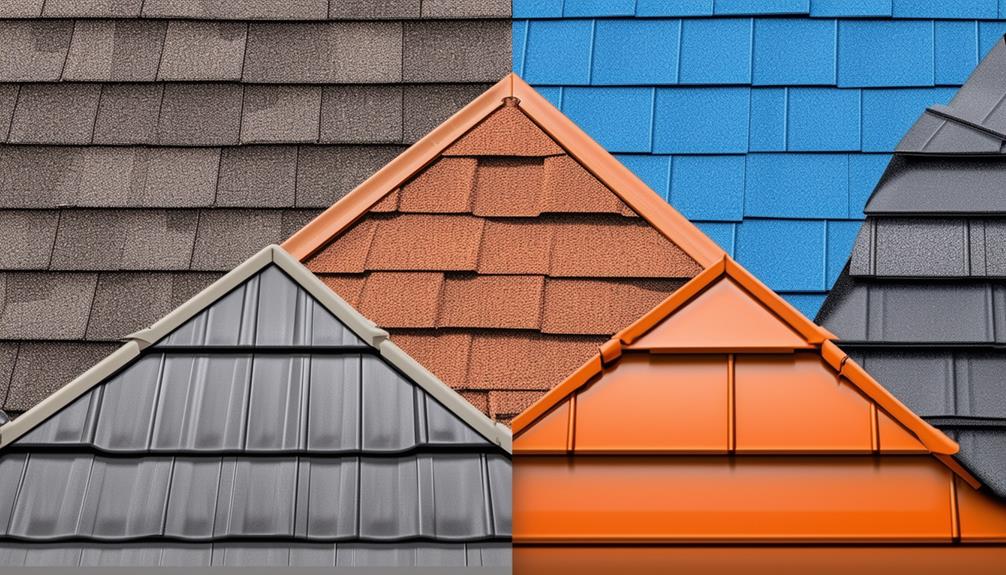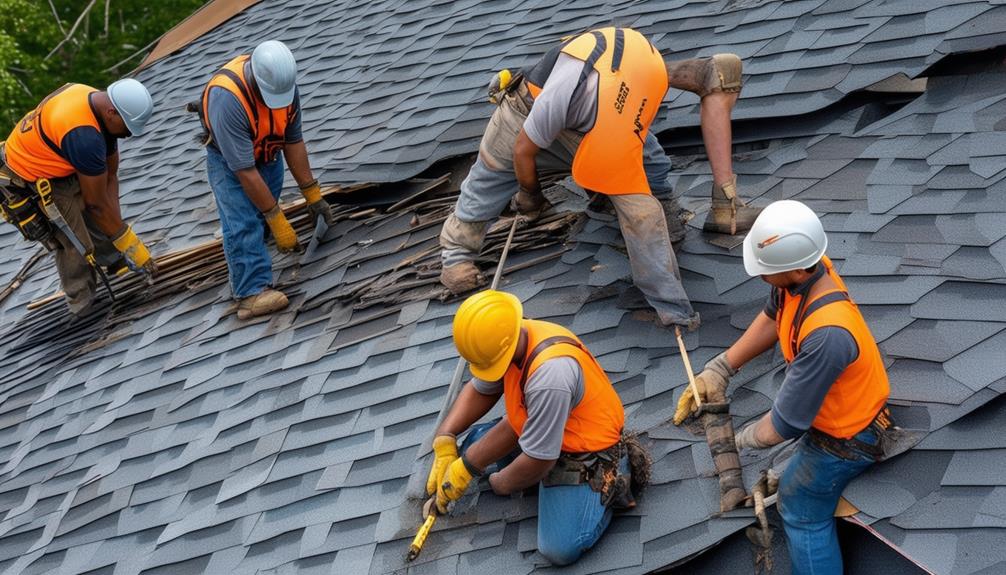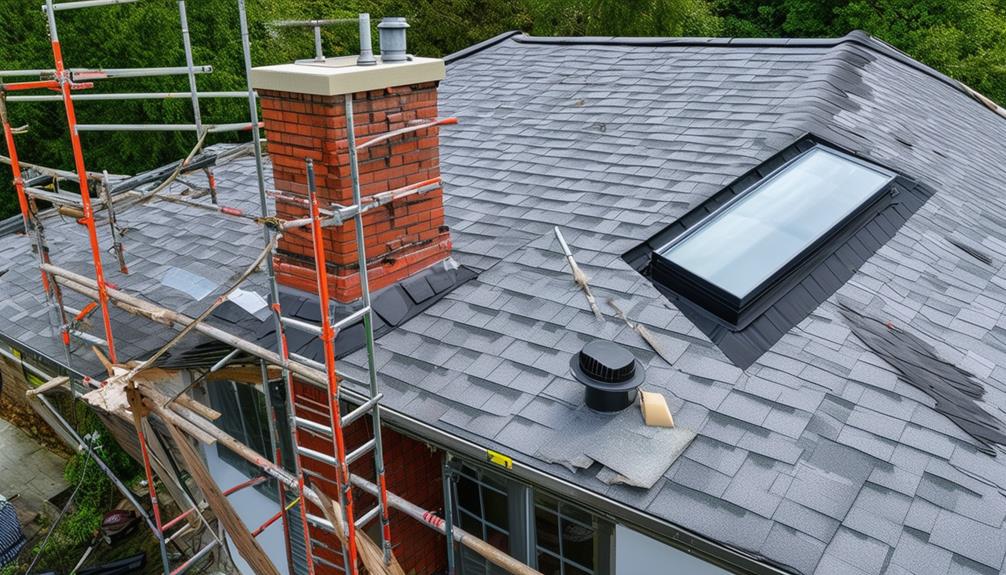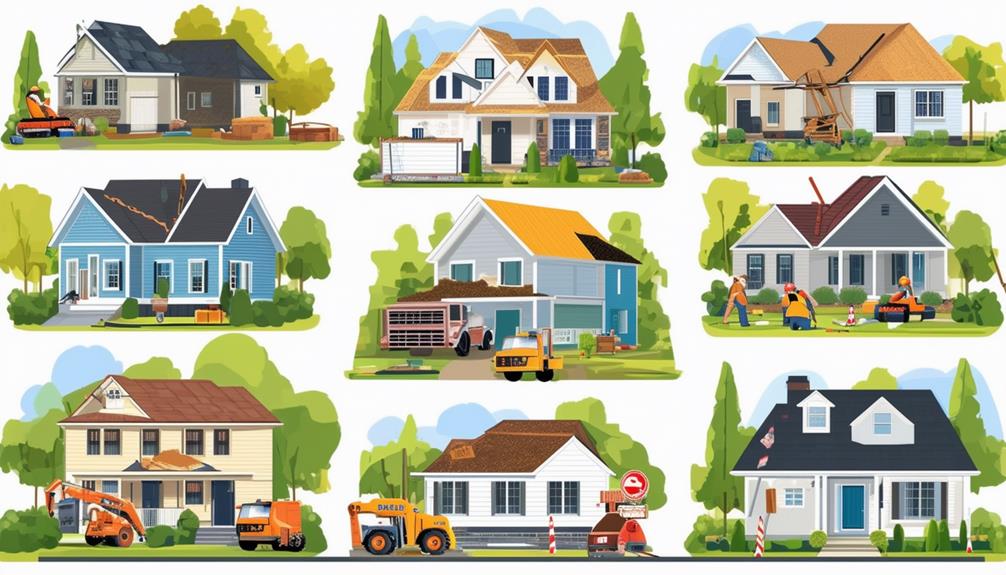When planning a roof replacement, consider the quality of materials like metal or slate for durability and energy efficiency. Roof size and pitch affect material and labor costs, with climate playing a role in material selection. Skilled labor and completion timeframes impact pricing, along with underlayment thickness and decking condition. Accessibility and obstacles influence cost and project duration. Warranty terms, including coverage and transferability, are important. Compliance with insurance requirements and permits is essential. Understanding these factors is necessary for a successful roof replacement project.
Roofing Material Quality

When considering the cost of roof replacement, the quality of roofing materials you choose plays a significant role in determining the longevity and durability of your new roof. Opting for high-quality materials may involve a higher initial cost but provides longevity benefits and cost-effectiveness in the long run. Durable materials like metal or slate roofs can last 50 years or more, requiring fewer replacements over time compared to traditional asphalt shingles.
Energy efficiency is another key factor influenced by the quality of roofing materials. Materials like cool roofs, which reflect more sunlight and absorb less heat, can help regulate indoor temperatures, reducing the need for excessive air conditioning. This not only cuts down on energy costs but also lessens the environmental impact of your home by lowering carbon emissions associated with energy consumption. Investing in energy-efficient roofing materials can contribute to a greener environment and lower utility bills over time.
Roof Size and Pitch
Considering the cost of roof replacement, the size and pitch of your roof are important factors that greatly impact the overall expenses and labor involved in the roofing project. Roof size directly correlates with material costs; the larger the roof, the more materials needed, thereby increasing expenses. Additionally, a steep roof pitch requires more labor and specialized equipment, which can add to the overall cost.
To save on expenses, consider maintenance tips such as regularly cleaning debris and checking for damage to prolong the life of your roof. Climate impact is also essential when selecting materials; eco-friendly options like metal roofs are durable and energy-efficient, reducing long-term costs and benefiting the environment. Consulting with a roofing professional can help you determine the most cost-effective and eco-friendly solutions for your specific roof size and pitch.
Labor Costs

When it comes to the cost of roof replacement, labor plays a significant role in determining the overall expenses. Skilled labor pricing can vary based on the complexity of the job and the expertise required. Additionally, the timeframe for completion is important as it can impact both the labor costs and the overall timeline of the project.
Skilled Labor Pricing
Skilled labor pricing for roof replacement typically accounts for a significant portion of the overall project cost. When evaluating labor costs, it is important to take into account the reputation of the contractor and the project timeline. Here are some key points to bear in mind: Additionally, the complexity of the roof design and the choice of materials can greatly influence the labor expenses. A detailed roofing installation cost breakdown provided by the contractor can help homeowners better understand where their money is going and ensure transparency. This breakdown often highlights not only the labor charges but also the allocation for equipment, safety measures, and any additional services.
- Contractor Reputation: Opting for a reputable contractor might come with a higher price tag, but it often guarantees quality workmanship and reliability.
- Project Timeline: Urgent projects or tight deadlines may incur additional labor costs due to the need for more workers to expedite the job.
- Skill Level: Highly skilled laborers may charge more for their expertise, but their work is likely to be of higher quality and last longer.
- Specialized Expertise: Certain projects, such as intricate roof designs or unique materials, may require laborers with specialized skills, which can affect pricing.
- Location: Labor costs can vary based on the region, with urban areas generally commanding higher rates due to increased demand and living costs.
Taking these factors into consideration can help you make informed decisions when budgeting for skilled labor in your roof replacement project.
Timeframe for Completion
For a roof replacement project, the timeframe for completion greatly impacts labor costs, influencing budget considerations and workforce allocation. The duration of a roof replacement project can have a significant effect on the overall labor expenses. Project delays are a common occurrence in construction, and they can lead to increased labor costs due to extended work hours or rescheduled workdays. When projects take longer than anticipated, additional labor hours are needed, resulting in higher expenditures. Weather impact is another critical factor affecting the timeframe for completion. Inclement weather conditions such as rain, snow, or extreme heat can cause delays in the roofing process, leading to increased labor costs. Workers may need to stop work during severe weather, prolonging the project timeline and requiring more labor hours to complete the job. It's vital to account for potential project delays and weather impact when estimating labor costs for a roof replacement to avoid budget overruns and efficiently allocate resources.
Underlayment and Decking
Confirm that the underlayment and decking of your roof are in good condition to provide a solid foundation for the new roof materials. The underlayment thickness and decking condition are vital factors to guarantee the longevity and effectiveness of your new roof. Here are five essential points to contemplate before proceeding with your roof replacement:
- Underlayment Thickness: Check if the underlayment meets the manufacturer's recommendations for your specific roofing material. Proper thickness helps protect against water infiltration and improves insulation.
- Decking Condition: Inspect the decking for any signs of rot, water damage, or structural issues. Ensure it is sturdy enough to support the new roof materials without compromising the integrity of the entire structure.
- Nail Heads: Make sure nail heads are flush with the decking to prevent punctures in the underlayment and potential leaks.
- Sealants: Check for any gaps or cracks in the sealants around vents, chimneys, and skylights to prevent water intrusion.
- Ventilation: Ensure proper attic ventilation to prevent moisture buildup that can damage the underlayment and decking over time.
Roof Access and Obstacles

Check the accessibility to your roof and identify any potential obstacles that may hinder the replacement process. Access challenges can have a major impact on the cost and duration of your roof replacement. Factors such as steep slopes, the height of the roof, or the presence of trees close to the house can make it more difficult for roofers to access and work on your roof. Clearing these obstacles before the replacement begins is vital to guarantee a smooth and efficient process.
Obstacle clearance is essential to facilitate the work of the roofing team. Objects like satellite dishes, antennas, or solar panels might need to be temporarily removed to allow for seamless roof replacement. Additionally, ensuring that the area around your home is clear of debris, tools, or equipment can prevent accidents and delays during the project. By addressing these obstacles beforehand, you can help streamline the roof replacement process and avoid unexpected costs.
Warranty and Insurance
When considering the cost of roof replacement, it is important to understand the warranty coverage and insurance requirements associated with the project. Warranty coverage can vary between different roofing materials and installation methods, impacting the long-term maintenance costs of your new roof. Additionally, insurance requirements may influence the overall price of the replacement, so it's vital to review your policy and guarantee compliance before starting the project.
Warranty Coverage
Understanding the warranty coverage included with your roof replacement is essential for ensuring long-term protection and peace of mind. When it comes to warranty and coverage, there are important factors to keep in mind:
- Warranty Limitations: It's important to grasp any limitations or exclusions specified in the warranty to avoid voiding the coverage.
- Coverage Details: Familiarize yourself with what aspects of the roof are covered under warranty, such as material defects or workmanship issues.
- Manufacturer Responsibilities: The manufacturer typically provides coverage for material defects, ensuring the quality of the roofing materials used.
- Installer Responsibilities: The installer's warranty covers the workmanship and installation quality, safeguarding against improper installation issues.
- Transferability: Check if the warranty is transferable in case you sell your home, as this can add value and appeal to potential buyers.
Insurance Requirements
Guarantee your roof replacement meets the necessary insurance requirements to protect your investment and property. When it comes to insurance, making sure that your roof replacement aligns with the coverage limits of your policy is essential. Coverage limits dictate the maximum amount your insurance provider will pay for a covered loss. Before proceeding with the replacement, review your insurance policy to understand the specific coverage limits for roof repairs or replacements.
Policy requirements also play a significant role in the insurance process. Insurers may have specific guidelines that must be followed when replacing your roof to ensure coverage. These requirements could include using certain materials, hiring licensed contractors, or obtaining permits. Failure to adhere to these policy requirements could result in a denied claim or reduced coverage.
To avoid any potential issues with your insurance coverage, it is essential to communicate with your insurance provider throughout the roof replacement process. By staying informed and meeting all coverage limits and policy requirements, you can safeguard your investment and property in case of any unforeseen damage.
Location and Permitting

Considering the location of your property and the necessary permitting requirements is essential before starting on a roof replacement project. Your property's location can greatly impact the cost and process of obtaining permits. Here are some key factors to keep in mind:
- Local Regulations: Familiarize yourself with the specific permitting process and regulations in your area. Each locality may have different requirements, timelines, and fees associated with obtaining permits for a roof replacement.
- Historic Districts: If your property is located in a historic district, additional approvals may be needed before replacing the roof to maintain the area's architectural integrity.
- Environmental Considerations: Some locations have environmental restrictions that may affect the materials you can use for your roof replacement.
- HOA Guidelines: If your property is part of a homeowners' association, be sure to check if there are any guidelines or restrictions on roof replacements.
- Permitting Costs: Factor in the costs of permits into your overall budget for the roof replacement project to avoid any surprises during the process.
Frequently Asked Questions
Can I Install Solar Panels During Roof Replacement?
During roof replacement, you can definitely integrate solar panels. The process involves selecting roofing materials that support solar panel installation. Opt for materials like asphalt shingles or metal roofing for easier integration. Confirm that your roof structure can handle the additional weight of solar panels. Coordinate with your roofing contractor and solar panel provider to plan the installation efficiently. With proper planning and the right materials, you can seamlessly incorporate solar panels during roof replacement.
How Long Will My Roof Replacement Project Take?
When it comes to estimating the timeline for your roof replacement project, several factors come into play. The process typically takes anywhere from a few days to a week, but unforeseen circumstances like weather conditions or material availability can cause project delays. To guarantee a smoother experience, it's best to discuss a detailed timeline with your contractor and be prepared for any potential setbacks that may arise during the project.
Are There Any Eco-Friendly Roofing Options Available?
When considering eco-friendly roofing options, you'll be glad to know there are sustainable materials available that offer numerous benefits. Opting for green roofing not only helps the environment but can also lead to cost savings in the long run. These materials are designed to be durable, energy-efficient, and often require less maintenance over time. Investing in eco-friendly roofing is a smart choice for both your wallet and the planet.
Can I Upgrade My Roof Ventilation During Replacement?
When upgrading your roof during replacement, you can enhance ventilation efficiency, leading to improved energy savings. Proper ventilation helps regulate temperature and moisture levels in your home, reducing the strain on your HVAC system and potentially lowering energy bills. By investing in upgraded ventilation as part of your roof replacement project, you can create a more comfortable and energy-efficient living environment for yourself.
Do I Need to Move Out During the Roof Replacement Process?
During a roof replacement, it's important to take safety concerns into account. While you don't necessarily have to move out, it's wise to plan for temporary accommodations, especially if there are children or pets at home. Noise, debris, and potential hazards could make staying on-site uncomfortable. Discuss with your contractor to create a plan that guarantees your safety and convenience during the roof replacement process.
Conclusion
Now that you've considered all the factors that go into the cost of roof replacement, you're ready to make an informed decision. Remember, the quality of materials, size of your roof, labor costs, and other variables can all impact the final price. Don't rush into anything – take your time, do your research, and choose wisely. Your roof is an important investment, so make sure you make the right choice.




